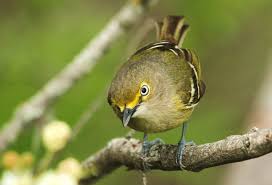Forget being eagle-eyed, small songbirds see at TWICE the speed of humans allowing them to view the world in slow motion
Small songbirds such as tits and flycatchers have some of the fastest eyes in the animal kingdom, capable of seeing at more than twice the speed of the human eye.
Their remarkable vision system, which is thought to be the fastest of any vertebrate animal, allows them to see the world around them in slow motion.
However, while their eye-sight may be fast, it is not nearly as detailed as other creatures, meaning their view is often blurry.
It shows that perching birds, or passerines, have eyes with an ‘input refreshment rate’, measured as something known as the temporal visual resolution, of up to 146Hz.
This is at least 50Hz faster than any other vertebrate, and well over twice as fast as the 60Hz a human eye can detect.
It is even faster than the 120 Hz refresh rates of the most expensive high-definition TVs.
The researchers said the small agile birds evolved this extremely fast vision because they need to track objects like small branches moving across their field of vision as they dodge predators.
In the case of flycatchers, this also includes catching fast moving insects on the wing, and means they also need to be able to predict where the bug is moving to.
Even so, the experimental results showed the vision of blue tits, collared flycatchers, and pied flycatchers is much faster than scientists would have expected based on their size and metabolism.
‘For passerines, the world might to be said to be in slow motion compared with how it looks to us,’ said Dr Anders Ödeen, a lecturer, who led the research.
The findings will also raise concerns about the welfare of small caged birds, especially those kept in areas with modern low-energy lighting.
Many types of compact fluorescent and LED bulbs flicker at 100 Hz, which is invisible to humans but not to the birds. Flickering can cause stress and disturbed behaviour in both humans and birds.
Yet it appears perching birds may have traded their ultra-sharp vision at the expense of sharpness.
While the record for the sharpest vision still rests with eagles, which can detect finer details than any other animal, perching birds can only see in low resolution.
Human with good eyesight can distinguish about 60 lines per degree of vision and eagles can discern up to 143.
Dr Ödeen said that neither tits nor flycatchers had yet been specifically tested, but similar small birds were thought to have spatial acuities of between 6 lines per degree in reed buntings and 22 in chaffinches.
He added: ‘Fast vision may, in fact, be a more typical feature of birds in general than visual acuity.
‘Only birds of prey seem to have the ability to see in extremely sharp focus, while human visual acuity outshines that of all other bird species studied.
‘On the other hand, there are lots of bird species similar to the blue tit, collared flycatcher and pied flycatcher, both ecologically and physiologically, so they probably also share the faculty of superfast vision.
Source: Daily mail
N.H.Kh

